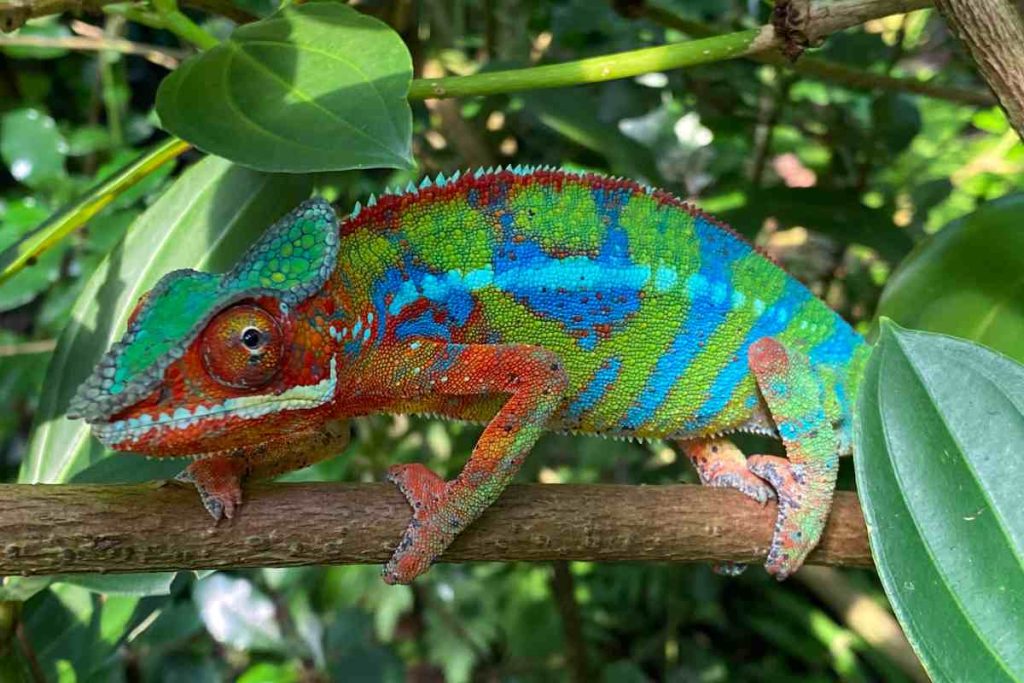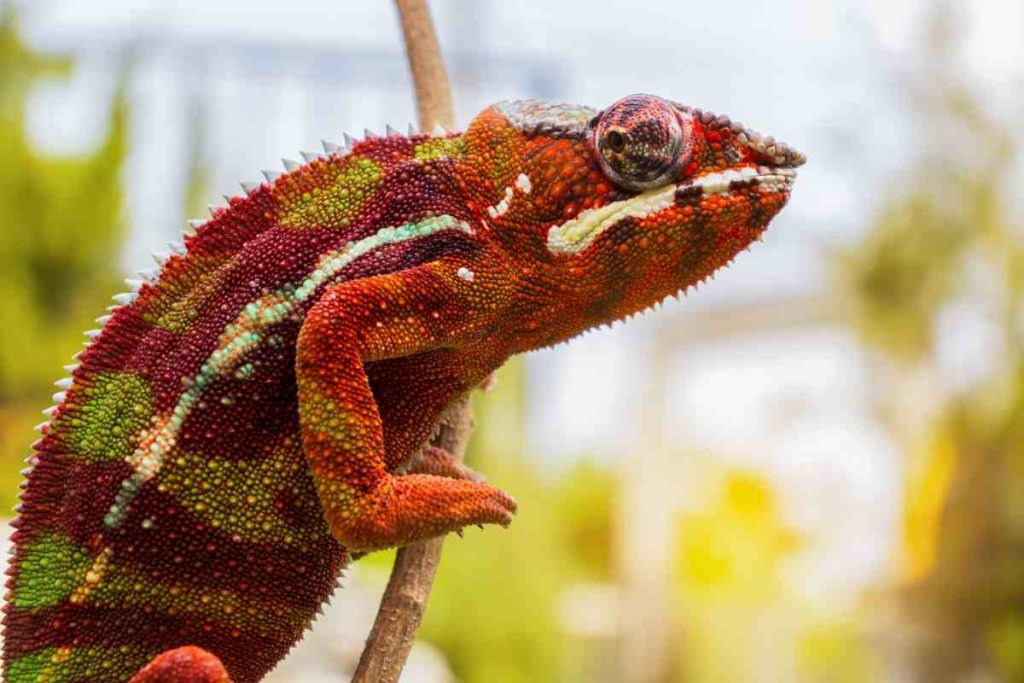Panther Chameleons are a species of chameleon native to the island of Madagascar. They are known for their unique ability to change skin color, vibrant and striking appearance, and fascinating behaviors. These reptiles have captivated the attention of scientists, nature enthusiasts, and pet owners alike.
Panther Chameleons belong to the family Chamaeleonidae, which includes over 200 species of chameleons. They are arboreal creatures, meaning they spend most of their time in trees and shrubs. Their long, prehensile tails and specialized feet allow them to navigate the branches easily.
The Colorful Camouflage: How Panther Chameleons Blend into their surroundings
One of the most remarkable features of Panther Chameleons is their ability to change their skin color to match their environment. This unique adaptation allows them to blend in with their surroundings, avoid predators, or sneak up on prey.
The color change is achieved through a combination of skin pigments and light’s reflection and scattering. Specialized cells called chromatophores are responsible for producing these pigments. When a chameleon wants to change its color, it expands or contracts these cells, altering the amount and distribution of pigments in its skin.
Panther Chameleons can display a wide range of colors, including various shades of green, yellow, blue, red, orange, and brown. They can also exhibit patterns such as stripes or spots. The colors and patterns depend on the chameleon’s mood, temperature, lighting, and surroundings.
A Rainbow of Hues: Exploring the stunning color variations of Panther Chameleons

Panther Chameleons are renowned for their stunning and vibrant color variations. Each chameleon has its unique combination of colors and patterns, making them truly one-of-a-kind.
The most common color variation in Panther Chameleons is green, which helps them blend in with the foliage of their natural habitat. However, they can also display shades of blue, red, orange, yellow, and brown. These colors can be solid or combined in intricate patterns, creating a mesmerizing display.
Some Panther Chameleons have a base color of green or brown with contrasting stripes or spots of a different color. Others have a gradient of colors, with one color blending seamlessly into another. The range of colors and patterns is genuinely astonishing and adds to the allure of these reptiles.
Habitat and Distribution: Where can you find these vibrant reptiles?
Panther Chameleons are endemic to Madagascar, meaning they are found nowhere else. They inhabit the eastern and northern regions of the island, including rainforests, coastal areas, and mountainous regions.
Within Madagascar, Panther Chameleons have a relatively broad distribution. They can be found in various national parks and reserves, including Montagne d’Ambre National Park, Andasibe-Mantadia National Park, and Ranomafana National Park.
The specific habitat requirements of Panther Chameleons vary depending on their age and sex. Juveniles prefer lower vegetation and shrubs, while adults are more commonly found in the canopy of trees. They require a combination of trees for perching and open areas for basking and hunting.
The Art of Changing Colors: Understanding the science behind chameleon pigmentation

The ability to change skin color is a unique adaptation found in chameleons. It is achieved through a complex biological process involving specialized cells called chromatophores.
Chromatophores are pigment-containing cells located in the skin layers of chameleons. They contain pigments such as melanin (which produces brown and black colors) and xanthophores (which produce yellow and red colors). When a chameleon wants to change its color, it expands or contracts these cells, altering the amount and distribution of pigments in its skin.
In addition to chromatophores, chameleons also have iridophores, which contain guanine crystals that reflect and scatter light. These crystals can create structural colors, such as blues and greens, by manipulating the reflected wavelengths of light.
The color change in chameleons is not solely for camouflage purposes. It can also be used for communication, thermoregulation, and expressing emotions. For example, a male chameleon may display bright colors to attract a female during courtship rituals.
Courtship and Mating: Unveiling the unique rituals of Panther Chameleons
Panther Chameleons have unique courtship behaviors and rituals that are fascinating to observe. Males use vibrant colors and elaborate displays to attract females and establish dominance.
A male chameleon will approach a female during courtship while displaying his most vibrant colors. He may also perform a series of head bobs, body movements, and tail flicks to impress the female. If the female is receptive, she will respond by displaying her colors and allowing the male to approach her.
Once the male has successfully courted a female, mating occurs. The male will grasp the female’s back with his front legs and align his cloaca with hers, allowing for the transfer of sperm from the male to the female.
After mating, the female will find a suitable location to lay her eggs. She typically digs a hole in the ground or finds a suitable tree cavity to deposit her eggs. The eggs are left unattended, and the female provides no parental care.
A Day in the Life: Observing the behavior and feeding habits of these fascinating creatures

Panther Chameleons are primarily diurnal, meaning they are active during the day. They spend their time foraging for food, basking in the sun, and engaging in social interactions.
In the morning, chameleons can see basking in the sun to warm up their bodies, helping regulate their body temperature and aiding digestion. They often choose a prominent perch, such as a branch or a tree trunk, to bask on.
Once warmed up, chameleons begin their food search. They are insectivores, meaning they primarily feed on insects such as crickets, grasshoppers, and flies. They use their long, sticky tongues to catch prey, which they consume whole.
Chameleons have excellent eyesight and can spot prey from a distance. They have independently moving eyes that can rotate and focus independently of each other, allowing them to have a wide field of vision and accurately judge the distance to their prey.
Threats and Conservation: The challenges faced by Panther Chameleons in the Wild
Panther Chameleons face several threats in their natural habitat that put their populations at risk. Habitat loss due to deforestation is one of the biggest challenges they face. The destruction of forests for agriculture, logging, and human settlements reduces the available habitat for chameleons and disrupts their natural behaviors.
Another threat to Panther Chameleons is the illegal pet trade. These reptiles are highly sought after as pets due to their vibrant colors and unique characteristics. However, capturing chameleons from the wild for the pet trade can harm their populations.
Conservation efforts are underway to protect Panther Chameleons and their habitats. National parks and reserves have been established to provide protected areas for these reptiles. Additionally, education and awareness programs aim to promote responsible pet ownership and discourage the illegal trade of chameleons.
Panther Chameleons as Pets: Can you keep these colorful reptiles at home?

Keeping Panther Chameleons as pets can be a rewarding experience, but it also comes with specific challenges and responsibilities. These reptiles have specific care requirements that must be met to thrive in captivity.
Providing an appropriate enclosure is one of the most important factors to consider when keeping a Panther Chameleon as a pet. Chameleons require a spacious, well-ventilated enclosure with plenty of climbing branches and foliage. The enclosure should also have proper lighting and heating to mimic their natural habitat.
Feeding a pet chameleon can also be challenging and require a diet consisting primarily of live insects, such as crickets, roaches, and mealworms. These insects must be gut-loaded with nutritious food before being fed to the chameleon.
Maintaining proper humidity levels is crucial for the health of a pet chameleon. They require high humidity levels, especially during shedding, to ensure their skin remains healthy. Regularly misting the enclosure and providing a water source for drinking and bathing is essential.
Fun Facts and Trivia: Interesting tidbits about Panther Chameleons you may not know
- Panther Chameleons have independently moving eyes, which allows them to have a 360-degree field of vision.
- They have a long, sticky tongue that can extend up to twice their body length to catch prey.
- The color change in chameleons is not only for camouflage but can also be used for communication and expressing emotions.
- Panther Chameleons have specialized feet that allow them to grip onto branches and climb quickly.
- They are solitary creatures and prefer to live alone, except during mating season.
- The lifespan of Panther Chameleons in the wild is around 5-7 years, but they can live up to 10 years in captivity.
Appreciating the beauty and wonder of Panther Chameleons
Panther Chameleons are truly remarkable creatures that captivate the imagination with their vibrant colors, unique behaviors, and incredible adaptations. Their ability to change skin color and blend into their surroundings is a testament to the wonders of nature.
By understanding and appreciating the beauty and diversity of Panther Chameleons, we can contribute to their conservation and ensure that future generations can continue to marvel at these mesmerizing reptiles. Whether observed in the wild or kept as pets, Panther Chameleons are a true wonder of the natural world.
More Sources: The Ultimate Master of Disguise in the Animal Kingdom

Leave a Reply